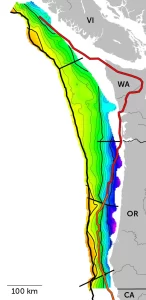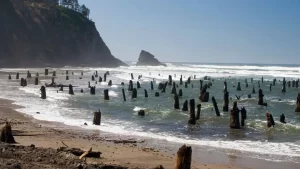
By NIKK OGASA/Science News
The most destructive Cascadian earthquakes are likely to slam offshore of Washington state and Vancouver Island and not necessarily the Oregon coast, new data reveal.
The Cascadia megathrust is a massive fault thought capable of generating devastating magnitude 9 earthquakes similar to the 2011 Tohoku temblor, but its structure has long eluded scientists.
Now, data from the most comprehensive survey yet show that the fault is not a single, continuous fracture but comprised of at least four segments. The most dangerous appears to stretch from off the coast of southern Vancouver Island through Washington state, researchers report in the June 7 edition of Science Advances.
“The Cascadia megathrust is a huge risk to people living in the Pacific Northwest,” says seismologist Edwin Nissen of the University of Victoria in British Columbia, who was not involved in the study.

While the portion of the fault extending from near Vancouver Island’s southwest coastline may be the most likely to host the largest earthquakes, he says, segments farther south along the Oregon’s coast may be more likely to experience slightly smaller and more frequent temblors.
Scientists found four segments along the fault, deepening the question about whether the whole fault will go at once, or whether segments could rupture individually.
“That’s the messy question, where the answer is more like: sometimes it does one thing, and sometimes another,” Harold Tobin, a seismologist at the University of Washington and an author of the paper, told The Washington Post.
Either scenario would constitute a major natural disaster, perhaps the difference between one magnitude-9 and two magnitude-8 earthquakes. Tobin pointed to a pair of massive earthquakes in Japan in 1944 and 1946 in which two different segments of a fault ruptured in short order, both causing deadly tsunamis.
Megathrust faults occur where two tectonic plates converge, especially in places where one plate pushes under the other, which is called a subduction zone. The plates typically get stuck and periodically slip, releasing immense amounts of earthshaking energy. Such settings have generated the largest temblors in history, including the 2004 Sumatra quake.
Off the west coast of North America, the Cascadia megathrust follows the shoreline from British Columbia to northern California. It is where the northeast-bound Juan de Fuca plate slides under the North American plate.

In the last 10,000 years, 19 quakes greater than magnitude 9 have rocked Cascadia. The most recent, a magnitude 9 that struck in 1700, dropped coastal forests into the tidal zone and fomented tsunami waves that reached Japan. The imminent threat of the next Cascadian quake has inspired a slew of articles, books, and documentaries.
And yet, compared with the megathrusts offshore Japan and New Zealand, the Cascadia fault is poorly understood.
“Most subduction zones have lots of small earthquakes occurring all the time, which give us a lot of information about the geometry of the faults,” Nissen says. Meanwhile, “Cascadia is eerily quiet in terms of seismicity.”
In 2021, marine geophysicist Suzanne Carbotte of Columbia University and colleagues aboard the Marcus G. Langseth research vessel conducted a seismic survey along a 900-kilometer stretch of the zone, towing underwater air guns that blasted sound waves into the seafloor. Faults and layers of rocks underground reflected these waves back upwards, where they were detected by a 15-kilometer-long array of receivers pulled behind the craft.
“It’s the first time that a regional survey that spans almost the whole subduction zone has been conducted,” Carbotte says. “Prior to this, people had looked at individual, small regions, like on the order of 200 kilometers at most.”
The data revealed that as the Juan de Fuca plate grinds under the North American plate, it splits into segments, like a sheet of plywood passing through a row of buzzsaws. This segmentation appears to be largely driven by the irregular distribution of rigid rocks in the overlying North American plate, which unevenly warp the incoming plate.
“That segmentation is really important because that’s one way to stop an earthquake,” Nissen says.
During an earthquake, a fault will start to slip at a single underground point, or hypocenter. The motion will then spread along the fault. Large faults provide more room for temblors to propagate, giving rise to bigger and longer-lasting quakes.
But if a fault is segmented, the breaks may prevent motion on one segment from continuing onto another, limiting how large a quake can get.
Nonetheless, it’s still possible for some quakes to spread across several — or all — of the segments, Nissen says.
“There’s evidence that 1700 was such an earthquake,” Nissen says.
The data also showed that the segment that extends from southern Vancouver Island is relatively smooth, making it easier for quakes to grow, and it appears to descend beneath the North American plate at a very slight angle, Nissen says, only about 2 to 4 degrees. The largest earthquakes generally occur on shallow dipping faults within subduction zones.
“If it’s shallow and really gently dipping, that means that the earthquake could potentially propagate much further to the east, and therefore to the coastline — and people living in Victoria, Seattle, Vancouver — than was previously thought,” Nissen says.
The study provides “a lot of information that can be used in assessing and forecasting earthquakes,” says Mark Petersen, a geophysicist of the U.S. Geological Survey in Golden, Colo. and chief of the National Seismic Hazard Model Project, who was not involved in the research.
Knowing the details of the fault’s geometry is crucial for gauging how close future quakes may get to major cities like Seattle, he says. The next update to the agency’s hazard model for the Pacific Northwest will be made in 2029.
The survey also revealed small faults close to the coast, which could potentially slip and generate tsunami waves. Waves spawned by a megathrust earthquake farther offshore would take minutes to reach the coast, Nissen says, but if these nearshore faults slipped too, the resulting tsunami could hit the beach much sooner.



Really good article. In college we went out with Brian Atwater to view the evidence of thrust events in the back tidal areas of Willapa Bay. It was pretty amazing to read his article on the 1700 event and then go out into the field and here him talk about.
I live in Naselle, about 30 min east of Ilwaco/Longbeach, Wash. After learning about the Cascadia fault and what it can do…before I moved here I pulled out the tsunami hazard maps before I bought my home. I figure if she and/or they as this article states, finally kick off in concert — if the tsunami doesn’t get me — I’m probably gonna be stranded for a bit. We are not prepared out here for an event as a community.
My father, a career expert in plate tectonics responded to his read of this article with
“- they know far too little to make realistic guesses about the future.”